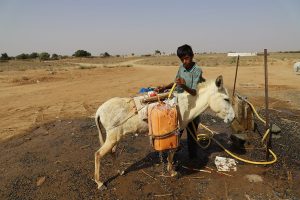BLOG: Fewer water leaks creates better government
Durban’s morning paper, the Mercury reported yesterday that South Africa annually loses close to US$ 450 million of municipal water revenues. This punishing cost occurs year-on-year due to leaks and from unpaid water supplied by municipalities (Non-Revenue Water or NRW).
The newspaper and its stark headline was lying at the entrance to the largest water symposium in Africa – the Water Institute for Southern Africa (WISA) Biennial Conference. I wondered why the paper was repeating a three year old story and concluded that it was because a perpetual financial loss of this magnitude is perpetually topical. This was a strong indicator of the problematique facing WISA delegates.
At the conference, an inaugural “No Drop” report detailing audited Non-Revenue Water data for the whole of South Africa was released. The release of this data was celebrated by many actors; from municipalities who supply water, to the national water authority that regulates them, to corporates and specialist water loss firms. Everyone was up-beat during the No Drop release event and chit chat focused on the future. Conversations held high hopes that innovative solutions to reduce NRW were on the horizon. Perhaps eThekwini Water & Sanitation, the 2014 winner of the Stockholm Industry Water Award, and the utility that supplies water to Durban will pull some ticks out of their innovation hat to reduce their 39% NRW. But despite this positive development, a broader problem remains. Why don’t municipalities in South Africa and utilities elsewhere in the world respond to two clear incentives for reducing water loss? That is the duality of dwindling water supply in proportion to demand and perpetual financial loss.
An upcoming report by SIWI and Frost and Sullivan analyses this question – in part concluding that this a classical conundrum of decentralised government.
Incentive misalignment occurs when the responsibility for a government function and the responsibility for the revenue that should be applied in fulfilling the function are assigned to separate institutions. In this case, water resources management authorities typically only control revenues that can be applied to supply-side-solutions for water security, e.g. dams and water transfer schemes. Funds that should be used for reducing demand for example through leak repairs are controlled by local governments or their entities. In this way, targets set by water resources management authorities cannot easily cascade to an independent self-governing sphere of government. The experts I spoke with mostly agree that financial incentives will provide greater leverage and opportunities for municipalities to act. One of numerous ideas proposed is a nationally financed facility designed to co-finance NRW projects. This ties into the ultimate effect of reducing NRW; improving the financial sustainability of local government.
As my colleague Josephine Gustafsson and I, head out of Durban, we inadvertently pass by a young person’s vocational training programme from the government’s War on Leaks programme. 10,000 unemployed youths across South Africa are being trained as plumbers and artisans and will repair leaks found on properties in their local communities. Another fantastic initiative that works holistically between social groups and social issues. All this activity and all these solutions ideas leave us excited and hopeful.
Watch this space for a SIWI and Frost and Sullivan report next month that quantifies the market size for NRW projects in Africa and the governance barriers that should be overcome for this potential market to be realised








